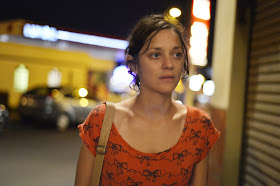I'm conflicted about the Dardenne brothers' latest film, Two Days, One Night (2014).
On the one hand, I think that in spite of the Dardennes' reputation as observational realists, they've constructed a film that is best understood as a moral fable. Oh, it's clearly the work of social realists. Its portrait of late capitalism has the kind of clear-eyed brutality that only comes from a long hard look at the world. Its structure and plot, on the other hand, seem like a trap built to produce a specific result for its characters. It's a gross manipulation, so if the intent is to make a film that indicts the current criminal economy, then it fails. You cannot arrive at "truth," even in fiction, if you rig the game. One of my correspondents calls the plot of Two Days, One Night "bullshit," and he's not exactly wrong.
On the other hand, Two Days, One Night features another astonishing performance by Marion Cotillard. You might expect that a movie star of Cotillard's magnitude would demolish the Dardennes' carefully cultivated observational aesthetic, but in Cotillard's case, she's a star of that magnitude in the first place because she's the most gifted actress of her generation. That is on full display in this film. She gives the Dardennes exactly what they want from a lead performance: natural, heartbreaking, without a hint of artifice. Would that the brothers tended their own garden as carefully.





